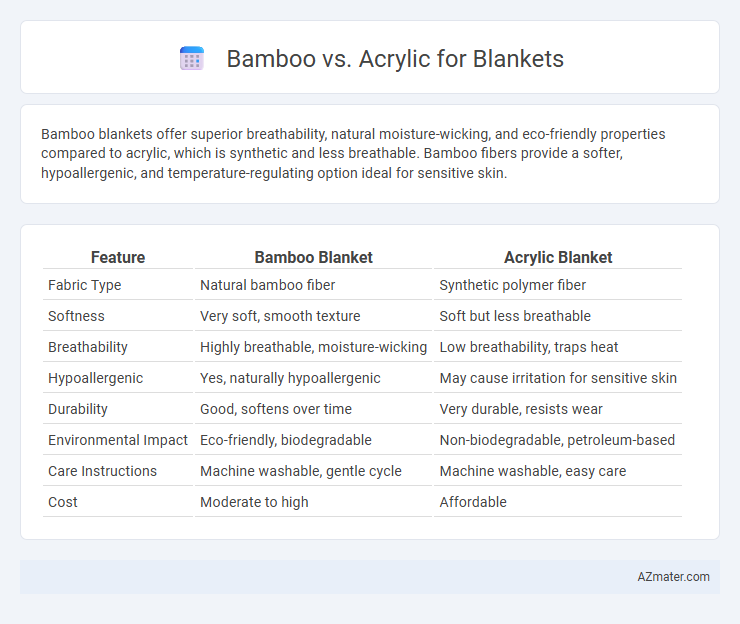Bamboo blankets offer superior breathability, natural moisture-wicking, and eco-friendly properties compared to acrylic, which is synthetic and less breathable. Bamboo fibers provide a softer, hypoallergenic, and temperature-regulating option ideal for sensitive skin.
Table of Comparison
| Feature | Bamboo Blanket | Acrylic Blanket |
|---|---|---|
| Fabric Type | Natural bamboo fiber | Synthetic polymer fiber |
| Softness | Very soft, smooth texture | Soft but less breathable |
| Breathability | Highly breathable, moisture-wicking | Low breathability, traps heat |
| Hypoallergenic | Yes, naturally hypoallergenic | May cause irritation for sensitive skin |
| Durability | Good, softens over time | Very durable, resists wear |
| Environmental Impact | Eco-friendly, biodegradable | Non-biodegradable, petroleum-based |
| Care Instructions | Machine washable, gentle cycle | Machine washable, easy care |
| Cost | Moderate to high | Affordable |
Introduction: Bamboo vs Acrylic for Blankets
Bamboo blankets offer exceptional breathability, moisture-wicking properties, and natural hypoallergenic benefits, making them suitable for sensitive skin and warmer climates. Acrylic blankets provide a lightweight, durable, and cost-effective alternative, featuring good insulation and resistance to moths and fading. The choice between bamboo and acrylic blankets depends on factors such as temperature regulation, environmental impact, and personal comfort preferences.
Material Composition and Origins
Bamboo blankets are made from viscose derived from bamboo pulp, offering a natural, sustainable alternative with antimicrobial properties and excellent breathability. Acrylic blankets consist of synthetic fibers made from polymerized acrylonitrile, originating from petrochemical sources and designed to mimic wool's softness while being lightweight and quick-drying. Bamboo's renewable plant-based origin contrasts with acrylic's reliance on fossil fuels, impacting environmental sustainability and material performance in blankets.
Softness and Texture Comparison
Bamboo blankets are renowned for their ultra-soft, silky texture due to the natural fibers derived from bamboo plants, offering a smooth and breathable feel ideal for sensitive skin. Acrylic blankets, made from synthetic fibers, tend to have a coarser texture and can feel less breathable, often lacking the luxurious softness associated with bamboo. The moisture-wicking and hypoallergenic properties of bamboo further enhance its comfort compared to the heat-retaining nature of acrylic materials.
Breathability and Temperature Regulation
Bamboo blankets offer superior breathability due to their naturally porous fibers that wick moisture and allow air circulation, enhancing temperature regulation and keeping users cool in warm weather. Acrylic blankets, made from synthetic fibers, tend to retain heat and trap moisture, which can lead to overheating and less effective temperature control. Choosing bamboo blankets ensures a more comfortable sleeping experience with better moisture management and cooling properties compared to acrylic options.
Durability and Longevity
Bamboo blankets boast exceptional durability due to their strong natural fibers that resist pilling and wear, ensuring long-lasting softness and comfort. Acrylic blankets, while more affordable, tend to have lower durability, as they can pill and degrade faster with repeated washing and use. Choosing bamboo blankets results in enhanced longevity and sustained quality, making them a superior investment over acrylic options.
Hypoallergenic and Skin-Friendliness
Bamboo blankets offer superior hypoallergenic properties due to their natural resistance to dust mites and mold, making them ideal for sensitive skin. Acrylic blankets, while budget-friendly and durable, may cause irritation or allergies in individuals with sensitive skin because they are synthetic fibers. Bamboo's moisture-wicking and breathable nature enhances skin-friendliness, promoting a comfortable and irritation-free sleep experience.
Sustainability and Environmental Impact
Bamboo blankets offer superior sustainability due to bamboo's rapid growth and minimal water requirements, making it an eco-friendly alternative to acrylic, which is a synthetic fiber derived from petrochemicals and contributes to microplastic pollution. Bamboo fibers are biodegradable and require fewer pesticides, reducing environmental toxins, while acrylic production involves energy-intensive processes and generates non-biodegradable waste. Choosing bamboo over acrylic blankets significantly lowers carbon footprint and supports renewable resource use, aligning with environmentally conscious consumer preferences.
Ease of Care and Maintenance
Bamboo blankets are naturally resistant to odors and stains, requiring gentle machine washing in cold water and air drying to maintain their softness and durability. Acrylic blankets are easier to care for due to their synthetic fibers, which dry quickly and resist wrinkles, typically needing only low-heat machine washing and drying. Both materials offer convenient maintenance, but bamboo demands more delicate handling to preserve its eco-friendly properties.
Price and Affordability
Bamboo blankets typically cost more due to their eco-friendly production and natural antibacterial properties, averaging between $50 and $100, while acrylic blankets are generally more affordable, often priced around $20 to $40. Bamboo offers better breathability and moisture-wicking capabilities, justifying the higher price for those seeking comfort and sustainability. Acrylic's lower price point makes it a budget-friendly option, but it may lack the softness and durability found in bamboo blankets.
Choosing the Right Blanket: Bamboo or Acrylic?
Bamboo blankets offer superior breathability, moisture-wicking properties, and natural antibacterial benefits, making them ideal for sensitive skin and warm climates. Acrylic blankets provide warmth, durability, and affordability, excelling in cold environments and easy maintenance. Evaluating factors like temperature regulation, allergen sensitivity, and budget will guide the choice between eco-friendly bamboo and cost-effective acrylic blankets.

Infographic: Bamboo vs Acrylic for Blanket
 azmater.com
azmater.com